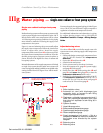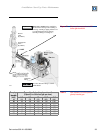
Part number 550-141-850/069932
GOLD GV Water boiler series 3 — manualGOLD GV Water boiler series 3 — manual
GOLD GV Water boiler series 3 — manualGOLD GV Water boiler series 3 — manual
GOLD GV Water boiler series 3 — manual
Water piping — radiator systemIIIf
Figure 12a Radiator system — zone-valve
zoning
Zone 2
Zone 1
85013b
Cold
water
fill
GV Boiler
12"
max
Figure 12b Radiator system — circulator
zoning
Zone 2
Zone 1
85017
Cold
water
fill
GV Boiler
12"
max
Legend
1 Boiler isolation valves
2 Automatic air vent (with diaphragm-type
expansion tank), or connect to tank fitting
(closed-type expansion tank).
3 Diaphragm- or bladder-type expansion tank, if
used. (For closed-type expansion tank, pipe
from top of air separator to tank fitting as in
Figure 10.)
4 Zone valve
5 System or zone circulator
6 Flow/check valve
7 Hose bibb purge valve
8 Boiler pressure/temperature gauge
Radiator system piping
Apply Figure 12a (zone-valve zoning) or 12b (circulator
zoning) to systems using standing cast iron radiators.
This applies to gravity water systems and converted steam
systems using columnar, tubular or recessed cast iron
radiators.
The suggested piping for zone-valve zoning radiator
systems differs from baseboard systems because of the
high water content of cast iron radiators. The GV internal
circulators automatically regulate supply and internal
bypass flow based on the temperature of the water
returning to the boiler. At the start of many heating cycles
in a radiator system, the water in the radiators is cool. So
the boiler would slow down system flow rate while
sending out relatively hot water. This could cause heat
distribution problems. Install a separate system circulator
as shown in Figure 12a when zoning with zone valves.
The separate circulator assures a relatively constant
temperature drop through the system.
The boiler internal circulators must be left in the boiler.
They cannot be removed for use a a zoning circulator.
Provide a circulator for each zone when circulator zoning,
and pipe the system as in Figure 12b.


















